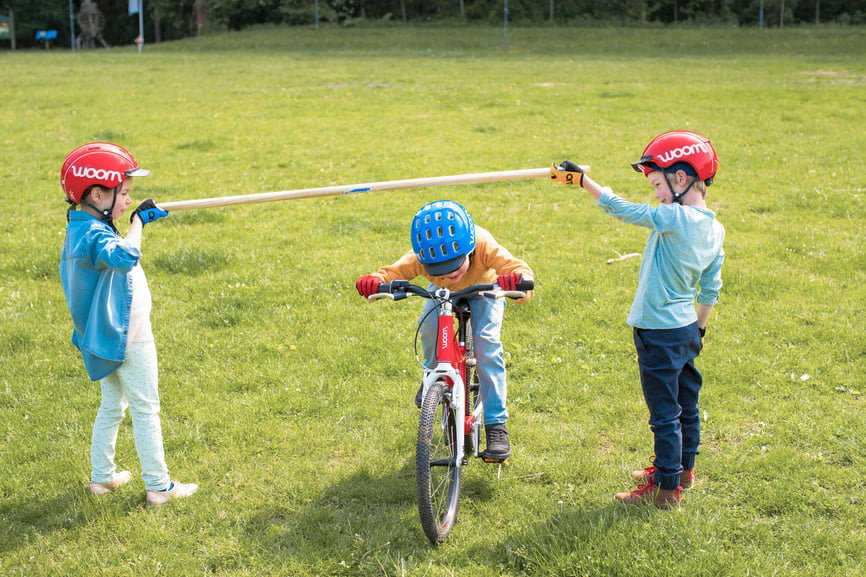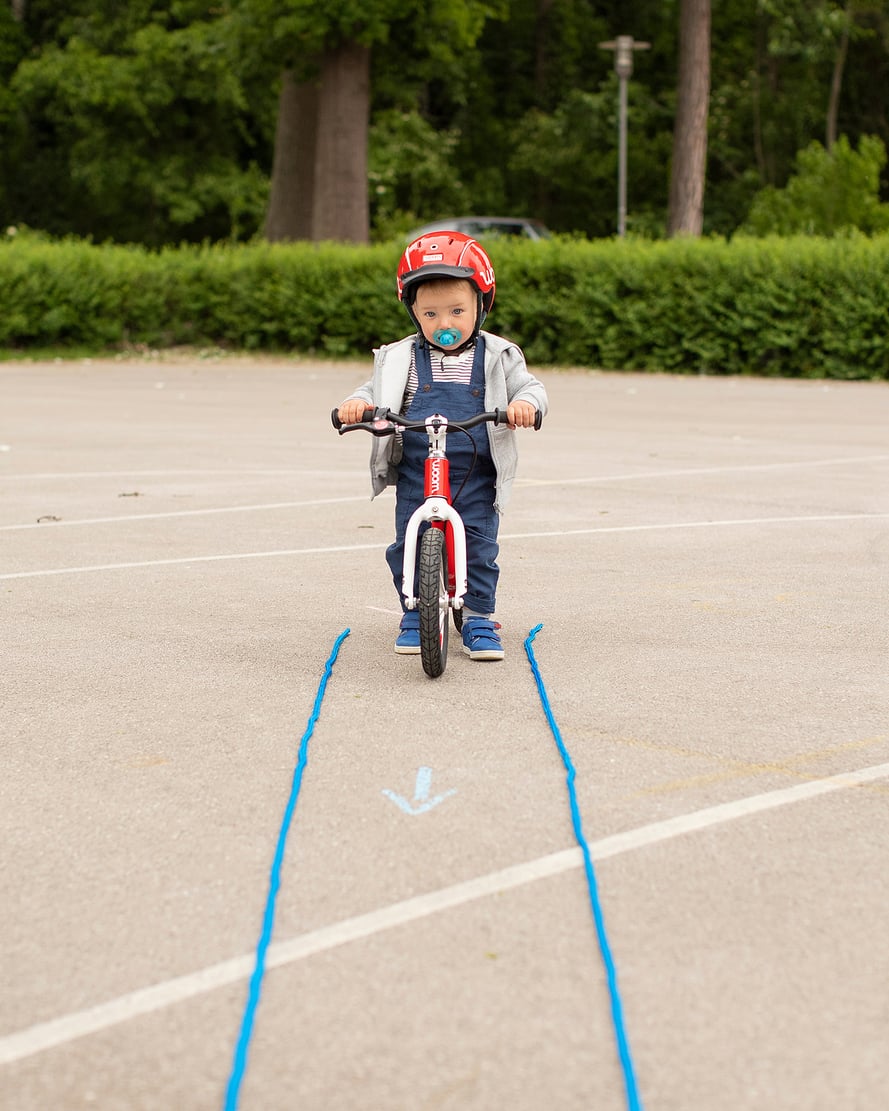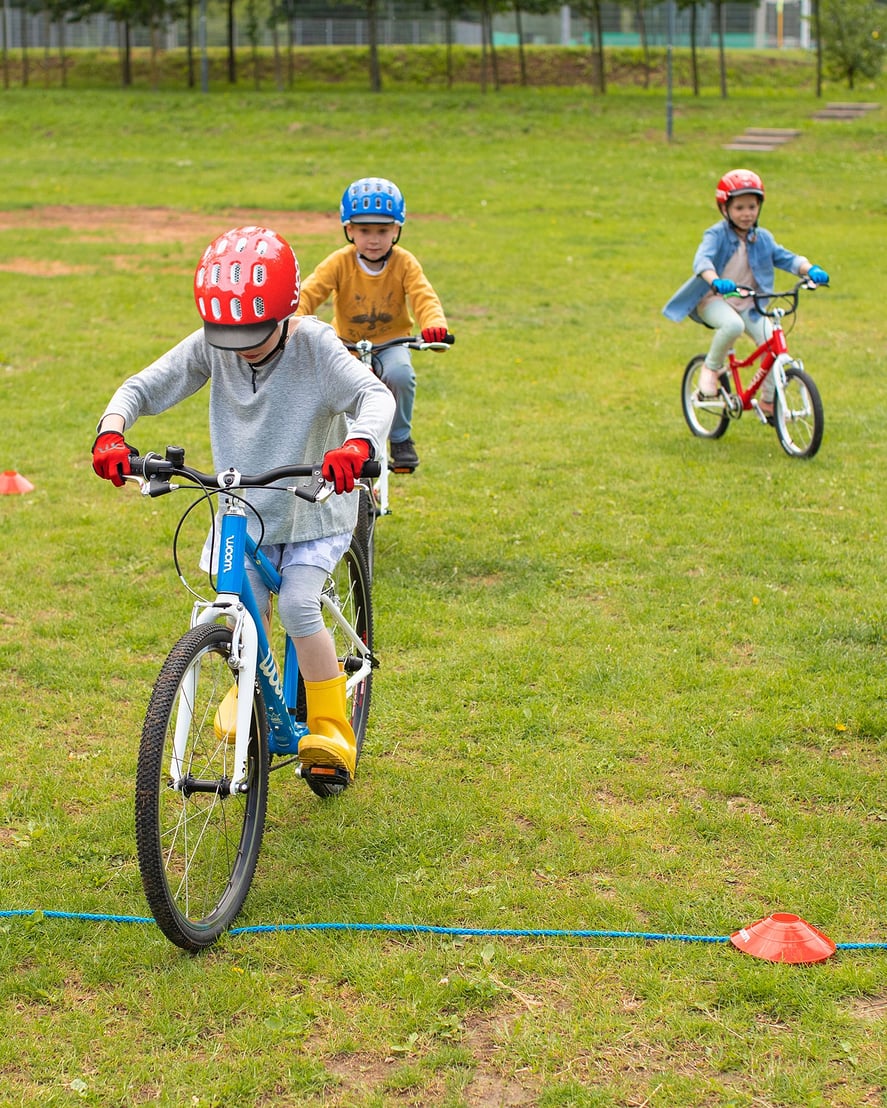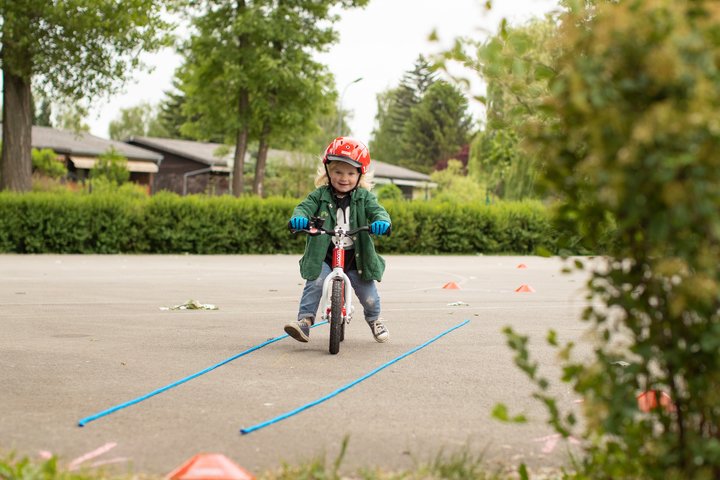Once your child has nailed pedalling, it’s time to take it to the next level with some special challenges. These exercises to refine their technique come loaded with fun and are a playful way to improve their riding. After all, whether on the trails, in the park or sharing the road with other users, the ability to securely handle their bike should never be underestimated.
So, go grab your bikes!
... wait, not so fast! You will need a few training tools, such as cones or buckets, some little balls, and floor chalk. Don’t be afraid to let your creative juices flow; it will make it all the more exciting for your child.
Find a location that is free from traffic with ample space for a small circuit. Before letting your child loose, you should explain or demonstrate each activity individually.

Challenge #1 – Cornering
Circles: Ride in a large circle, asking your child to keep at a short distance from your wheel. Gradually decrease the size of the circle with each loop.
Figure-of-8: Draw a large figure-of-8 on the ground and encourage your child to follow the line – first in one direction, then the other. They will likely find one direction easier than the other – that’s totally normal; we all tend to have a more dominant side.
Next level: confident, advanced children can try both of the above tasks using one hand. Tip: check out challenge #4 beforehand as this focuses on developing one-handed riding.

Challenge #2 – Stay on track
As cyclists, we are often expected to ride within certain spatial confines, such as staying inside bicycle lanes or keeping within a trail’s natural borders. Here's where staying on track is key.
Draw two parallel lines in a sort of corridor on the ground. Your child’s challenge is to ride along the whole corridor without touching the boundary lines.
Next level: Decrease the width of the corridor as it goes along. Alternatively, draw it in the shape of a spiral and set the challenge of riding from the outside inwards – once again, taking care not to touch the lines.
Challenge #3 – Slalom
Dodging obstacles is an art that requires precise and confident steering.
To begin the Slalom challenge, place the cones at a generous distance from each other.
To take it to the next level: Decrease the gaps between the cones. Or why not add an element of competition with a start and finish line? See who clocks the quickest time – guaranteed fun for your child.
Challenge #4 – Riding one-handed
Being able to ride confidently with one hand on the bars is a must-have skill. It's crucial for riding in traffic where your child will need to signal at junctions. As always, don’t rush the process.
Step 1: Ask your child to ride at an average speed without pedalling. They should then try to loosen the grip of one hand on the bars. When they feel ready, lift it briefly from the bars. Go by go, they can practise removing it further from the bars. Once they have nailed that with confidence, they can try doing it while pedalling.
Step 2: Hold your arm at the height of your child’s shoulder with a ball in your hand. Encourage your child to work up some speed on the bike. As they pass by, they try to grab the ball without steering off-course.
Challenge #5 – Peripheral vision
When sharing the road with other users, it’s imperative that your child is actively aware of their surroundings. This involves a shoulder check before reaching a junction or making a turn.
One way to practice this sort of conscious checking is to get your child to ride past you; as they do so, you hold up a certain number of fingers or a small object. Their challenge is to glance over their shoulder and spot the number or recognise the object. Then call it out to you.

Challenge #6 – Pin-sharp braking precision
Whether at a stop sign or an unavoidable obstacle, controlled braking is key to staying safe. With a little bit of practice, your child should easily master this.
Draw a line in chalk or position some cones in a line. Your child then positions themselves for a run-up and rides up to the line with a bit of speed. The aim is to brake in a timely fashion so that they come to a halt before, or even better, on, the line. Mark where their front wheel finishes each time on the ground in chalk. This will allow them to monitor their progress. Their aim is to get closer to the line each time without touching it. They can increase the pace each time too.
Next level: Add an element of balance training to this challenge. Choose softer ground, such as a lawn or playing field. Your child rides towards you, then brakes in a controlled manner until coming to a standstill. The challenge here is to then restart their ride without touching the ground. Tip: track-standing like this is much easier if your child keeps the pedals parallel to the ground.
Challenge #7 – Keeping balance
Going fast is something kids usually pick up quickly. But knowing how to ride slowly takes some practice. It's a great way for your child to fine-tune their balance.
Why not have a little competition? Take your places on the start line. It's a slow bicycle race, where the winner is the last one over the line without having put a foot on the ground!
Next level: outline a rectangle on the ground. Make it around 2 metres x 1 metre in size. The challenge is to stay on the bike, not touch the floor, and keep within the lines. As soon as a foot touches the ground, the game restarts. See how long they can last by timing with a stopwatch. Don't be afraid to have a go yourself.
Challenge #8 – 'The attack position'
Your child is going to spend the majority of their time on the bike in the saddle. But uneven surfaces and bumpy tracks are often best tackled out of the saddle so that your child's legs and arms work as additional suspension. What's more, most downhills are also ridden out of the saddle. Therefore it's important to make sure that your child gets some practice in:
Find a flat, straight stretch and get them to ride at a decent pace – they then stop pedalling and free-wheel – position the cranks parallel to the floor – rise from the saddle – arms and legs bent slightly to absorb any bumps – elbows outwards – shoulders over the bars – hips over the bottom bracket – eyes looking straight ahead. This is called 'the attack position.'
Challenge #9 – Popping the front wheel
Once learned, never forgotten! The art of lifting the front wheel from the ground for a moment makes it significantly easier to pop up and over obstacles like pavement kerbs and roots. It's an advanced challenge, so make sure your child is ready to embark on it after having mastered the rest.
Here's what they need to do: pick an obstacle, such as a twig – pedal towards chosen obstacle and lift the wheel just before reaching it. This involves bending their arms and pulling the bars gently upwards. They will need to shift their weight towards the back of the bike while doing this. Once the wheel is in the air, they will need to soften its return to the ground.
The challenge here is all about timing – picking the right moment to lift the wheel in order to clear the obstacle. Your child should master this skill on the flat before challenging themselves to pop up onto the kerb.
Challenge #10 – Drifting
Gravel can be pretty daunting for many children. This often stems from unwanted skidding or crashing due to a child's unintentionally excessive or abrupt braking. To avoid accidents, it's wise for your child to better acquaint themselves with a loose surface and discover how said surface responds to riding and braking styles.
Keep it fun: Practise on a flat, quiet gravel or woodland track. Define where the stop line is. Begin by simply asking your child to ride slowly and bring the bike to a standstill before the line. Make sure that the line is clearly visible so that they can orientate themselves, and try to stop closer to the line each time.
Explain that in wet conditions, things can be extra slippery, such as the white paint of pedestrian crossings or leaves on the ground.
Good luck and have fun dialling in these skills!


.jpg?width=926&upsize=true&name=woom_still_and_moving_in_action_2018_345-Edit-720x480-32ef3212-c95f-4d63-b83a-d57bf7c038f6%20(1).jpg)
